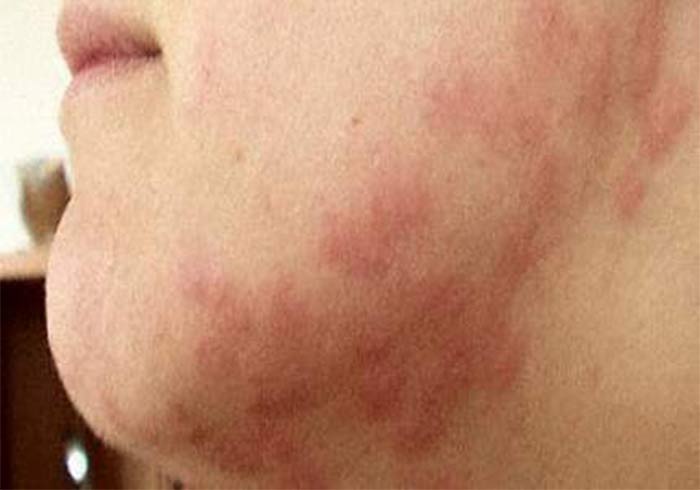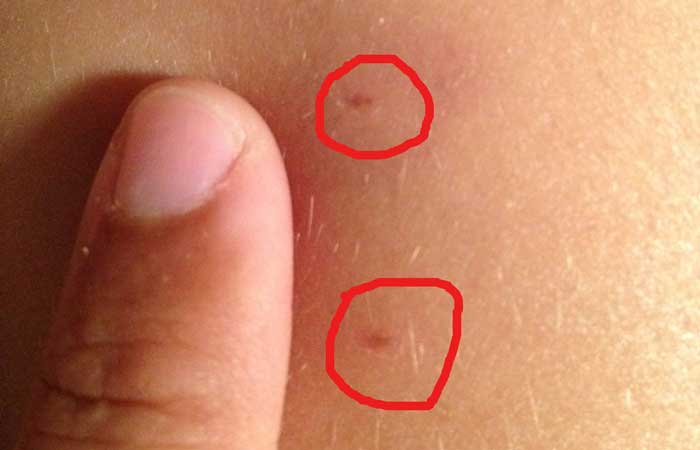The truth is that dust mites do not bite but rather cause an allergic reaction when they come into contact with your skin. They neither have teeth nor a tongue. They break down their food using digestive enzymes.
Let’s find out more the bite pictures on human skin and face, allergic reaction, symptoms, how to get rid and prevent the mites from biting you.
Table of Contents
Dust Mite Bites Pictures on Human & Rash
Following are pictures of how the “bites” look like. In the actual sense, these are not bites reactions on the skin.

What do Dust Mite Bites Look Like?
When you hear of dust mite bites, you should simply think of the allergy caused by the dust mites.
In most cases, the allergic reaction of your skin to dust mites is characterized by red itchy bumps that may be spread over a certain area of your skin.
If you suddenly feel an itch on your skin and then looking at it you find that your skin has turned red and you cannot spot any creature on your skin, it is likely that your skin is reacting to dust mites.
The way dust mite bites look like is similar to bites from many other creatures such as bed bugs.
To differentiate the bed bug bites from dust mite bites, you will need to keenly read the differences discussed later in this article.
Allergic Reaction to Dust Mite Bites
A good portion of the dust in your home is composed of dust mite feces and decomposing dust mite bodies. Quite many individuals who believe they’re allergic to dust really have an allergy to this protein-rich dust, which often triggers symptoms of asthma and hay fever.
However, it has been established that when a person has an allergy to dust mites, they are usually also allergic to other allergens.
Symptoms
Symptoms of dust mite bites are similar to those of allergy and asthma. That makes it easy to tell if the rashes on your skin are due to dust mite bites.
When attempting to find out whether you have dust mite bites, you should not only focus on your skin but on other symptoms as well. They include the following;
- Skin rash with red blotches
- Irritation on your skin
- Broken skin
- Sneezing and a runny nose
- Shortness of breath
- Swollen lips and tongue
- Intermittent cough
- Itchy and red or watery eyes
- Stomach pain, nausea, vomiting
When you suspect that you have dust mite bites or allergy reaction, do not look for all the symptoms since you may only have a few. This will depend on the severity of the allergic reaction and it varies from one person to another.
How to Deal with Dust Mite Bites
The first and safest step to ensure that you’re getting the best treatment for any insect bite or reaction is visiting a medical professional. They will do a check up and determine the most appropriate procedure to deal with problem.
According to health practitioners, antihistamines work well for this allergy reactions. Antihistamines reduce the chemical released by your body when you come into contact with dust mites. The reduction of the chemical release prevents the occurrence of an allergic reaction.
They not only stop any itching on the skin, mouth or nose; but they also stop any sneezing or runny nose. The antihistamines prescribed in most cases are Clarinex tablets and Allegra tablets.
Just like other allergies caused by other types of mites, you can use the following natural remedies that are thought get rid of the bites. The most common is the use of essential oils including;
Tea tree oil
Due to its anti-inflammatory properties, tea tree oil has been found to be very effective in reducing the inflammation and itching which is caused by dust mite allergy.
Once you have confirmed that you have dust mite bites (or allergy), add a few drops of tea tree oil to a natural lotion, oil or moisturizer, or even natural butter then apply it on your skin until the inflammation and itching goes away.
Coconut oil
Coconut oil has both antibacterial properties and a soothing effect. When your skin reacts to dust mites, you may be very uncomfortable with the itching.
When you scratch your skin, you are likely to expose it to many other infections.
Coconut oil comes in handy to soothe your skin of the itchiness as well as prevent the possibility of further infections.
You are advised to use virgin coconut oil for the highest level of effectiveness. You are required to apply this oil on the affected skin every morning and evening until the itch is gone and your skin no longer feels uncomfortable.
Aloe vera
Aloe vera constitutes of enzymes, minerals and vitamins all of which give your skin better health.
Aloe vera has anti-inflammatory properties which help reduce the itching and swelling on your skin following dust mite allergy.
To acquire the best of aloe vera, you should use pure aloe vera gel. Apply it on the part of your skin that has reacted with dust mites two to three times daily.
This will keep your skin hydrated and prevent any further itch. You are advised to mix aloe vera gel with other oils such as tea tree oil for better results.
Lavender oil
Lavender oil is used to treat very many allergies. It is considered one of the best options for skin allergies since it has healing and soothing effects and it therefore relieves you of the skin irritation caused by dust mites. You can apply a few drops of the oil on the affected skin or add the oil to lotion or baths.
Chamomile
This oil has anti-inflammatory properties which have been tested and found to be effective in reducing the inflammation and itch which is caused by dust mite.
You are advised to mix this oil with carrier oil and then apply it on the affected skin.
Where dust mite bites result to other symptoms that are not just skin irritation, a rash or other hives, you can still use the above essential oils but now, not topically. There are two main ways you can use the essential oils to treat other symptoms such as respiratory problems.
Firstly, you can inhale the essential oils directly. You can put a few drops of the oil on your handkerchief then breathe it in.
Alternatively, you can breathe in the essential oil when it is in its storage bottle.
Secondly, you can use the essential oils by diffusion. Here, you add the oil to an oil burner or plug-in-diffuser.
Prevention
Following are some ideas to prevent the mites in your home
- Use special bedding
- Taking extra precaution on pets
- Use a dehumidifier
- Regular cleaning
- Replace old pillows
- Avoid some unnecessary home decor like wall carpets
- Open your windows frequently
- Replace soft furnishings
- Allow your bedding to air
Further Reading: How to Kill & get rid of Dust Mites Naturally, with Chemicals + more Remedies
Further Reading
- Does Lysol Kill Dust Mites
- Dust Mite Allergy- Rash, Symptoms, Get Rid & Prevent
- Essentials Oils for Dust Mites
- Can you See Dust Mites? Pictures, They look like, Habitat, Food & more Facts
- Dust Mite Bites, Pictures, Signs + Ridding
- Dust Mite vs Bed Bug Bites
- How to get rid of Dust Mites- Natural Remedies & Chemicals
Sources
- https://www.medicalnewstoday.com/articles/320225.php
- http://www.slumberslumber.com/sleep-clinic/bed-bugs/bed-bugs-and-dust-mites/
- https://bedbugtreatmentsite.com/dust-mite-bites-bed-bug-bites/



